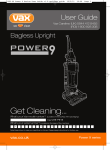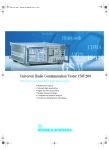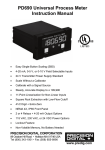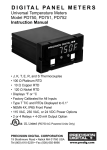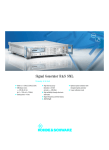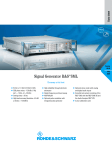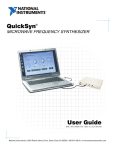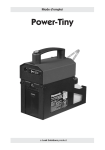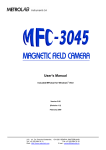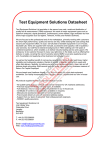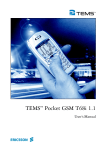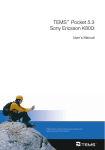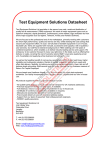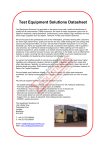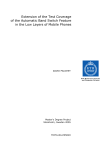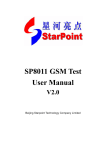Download rohde & schwarz cmu300
Transcript
Universal Radio Communication Tester CMU300 The base station tester for current and future mobile radio networks ◆ ◆ ◆ ◆ ◆ Extremely high-speed testing Highly accurate measurements Modular future-proof design Comprehensive spectrum analyzer and signal generator Upgradability to 3rd generation technologies The CMU300 – a new generation in base station testing Rohde&Schwarz milestones in digital testing 1990 CMTA94 The first test set for GSM transmitter and receiver testing. 1991 CRTS02/04 Signalling tester for GSM mobile and base stations. 1992 FTA Sole supplier of the GSM900 system simulator for conformance testing of mobiles. 1993 ITA Sole supplier of GSM900 interim conformance test system, upgradable to GSM1800. Rohde & Schwarz has always been at the forefront of mobile radio technology. For more than 60 years now we are developing solutions for our customers. The CMU300 carries on this tradition. As a high-end communication tester platform for base stations it completes the Rohde & Schwarz product portfolio. The CMU300 reflects the long-standing expertise Rohde & Schwarz has gained in the world of mobile communication and base station testing in different fields such as production, R&D, commissioning, system test, service and maintenance. The CMU300 is designed to provide a flexible platform for customized solutions and testing with maximum speed, top accuracy and optimum repeatability. Its home is the world of digital mobile networks of generations 2 and 2.5. As a today‘s investment in the future it is prepared already for 3rd generation testing. Ask your local Rohde&Schwarz representative for a demonstration and help to find out about your requirements. 1994 CMD55/57 The world‘s first compact digital radiocommunication tester for GSM mobiles and base stations. 1996 CRTP/C02 Approved as standalone tester for conformance testing of GSM900/1800 phase II mobiles. 1997 TS8915 Supplier of the first conformance test system for GSM1900. 1997 CMD65 The world‘s first compact digital radiocommunication tester for GSM900/1800/1900 and DECT. 1999 CMU200 THE cellphone tester for current and future mobile radio networks. 2000 CMU300 Base station tester for current and future mobile radio networks. The CMU300 can handle a wide range of applications, but is primarily optimized for the high accuracy and speed demanded in an ever more quality-conscious manufacturing process. The picture shows the front panel for desktop use 2 Universal Radio Communication Tester CMU300 CMU300 BTS BSC CMU Abis interface CMU - B71 CMU BER analyzer Signalling CMU PN generator BTS PN generator Channel decoder CMU BER loop Channel coder Modulator Demodulator CMU RAW BER loop "burst by burst" RF switching matrix Modulator RF BTS RAW BER loop "burst by burst" Demodulator Frame clock IN Channel coder Frame clock OUT BSC PN generator BTS BER loop Interface board Channel decoder BTS RAW BER analyzer Control of BTS/ setup of channels BSC BER loop BSC BER analyzer BTS BER analyzer MMI / LMT controller The CMU300 concept guarantees flexible adaptation to different customer-specific test environments, plus realtime channel coding/decoding capability There are different approaches to testing receiver and transmitter characteristics of modern base stations. The Universal Radio Communication Tester CMU300 represents a unique compact test solution, based on a generalpurpose RF generator and RF analyzer in conjunction with a powerful signalling unit. The capability to generate and decode signals for different channels in realtime is the key argument for compact one-box solutions. This is the main prerequisite for bit error rate (BER) tests and signalling at higher layers; the tester is able to simulate the functions of mobile stations. The concept of the CMU300 allows easy adaptation to customer-specific BER test environments. Certain BER signal paths are supported. Additionally, for flexible connectivity to possible RF interfaces of BTSs, the tester incorporates a powerful, user-configurable RF switching matrix. Universal Radio Communication Tester CMU300 3 Key strengths The Radio Communication Tester CMU300 ensures premium cost effectiveness through a variety of features, with extremely fast measurement speed and very high accuracy being the two most important ones. In addition, the secondary remote addressing of the unit’s modular architecture makes for intelligent and autonomous processing of complete measurement tasks and fast control program design. Greatest accuracy In a production environment the unit’s high accuracy allows DUTs (devices under test) to be tested for optimal mobile network performance. In the lab, the CMU300 enables the development engineer to replace conventional, dedicated premium-quality instruments more often than any other radio communication tester and save desktop space at the same time. High-precision measurement correction over the whole frequency and dynamic range as well as compensation for temperature effects in realtime are critical factors for achieving the CMU300’s excellent accuracy. The new, globally standardized Rohde&Schwarz calibration system can check the CMU300’s accuracy in a service center close to you or, volume permitting, on your premises. A worldwide network of these standardized automatic calibration systems has been implemented in our service centers. Highly accurate and repeatable calibration can be performed wherever you are. Your local Rohde&Schwarz representative offers customized service contracts for the unit. 4 Universal Radio Communication Tester CMU300 Greatest speed ProbeDSP™ technology The high processing speed is due to extensive use of ProbeDSP™ technology, parallel measurements and innovative remote command processing. These three aspects of the performance of the CMU300 are explained in more detail below. The modular architecture relies on decentralized ProbeDSP™ processing coordinated by a powerful central processor. Like an oscilloscope probe, DSPs dedicated to a specific local data acquisition and evaluation workload help to keep subsystem performance at an uncompromised maximum even if additional modules are fitted to the CMU300 mainframe. Key advantages of the CMU300 Speed Single measurement up to 10 times faster than with the previous generation of instruments Accuracy Three times more accurate than the previous generation of instruments with excellent repeatability Modularity Modular hardware and software concept provides easy extension to enhanced functionality Bullet-proof Low component count, low power consumption, and effective heat conduction result in unparalleled reliability Future-proof Easy migration to future standards Innovative remote processing Greatest reliability The novel secondary addressing mode can address similar functions of each of the CMU300´s subsystems (different mobile radio standards) in an almost identical way. Using this type of addressing, new remote test sequences can be programmed by a simple cut and paste operation followed by editing specific commands to adapt the control program to the new application. Secondary addressing is fully SCPI-compliant, which means that a subsystem address, for example "GSM1800", can be replaced by a string denoting a different subsystem (another mobile radio standard). The keys to the high reliability of the CMU300 are the low power intake and the innovative cooling concept. Less power means less heat. Power consumption is way below 200 W due to specially selected low-power components, the minimum component count concept, plus low voltage design wherever possible. The CMU300 employs an ultra-effective heat management between housings and individual components as well as between heat sinks and air flow. Independent cooling cycles for the front module controller, the power supply unit and the RF frontend add up to an optimized cooling system. Universal Radio Communication Tester CMU300 5 Base unit As the CMU300 has a modular architecture, the base unit comes without any network- or standard-specific hardware and software. The base unit can be used for testing the general parameters of RF modules at early production stages. Constituent parts of the CMU300 base unit are the RF generator and RF analyzer, which are completed by a versatile network-independent time domain menu and a comprehensive spectrum analyzer. Besides the convenient operational concept, the spectrum analyzer stands out for a continuous frequency range (10 MHz to 2.7 GHz) and several selectable resolution bandwidths. The zero span mode represents a separate operation group with sophisticated trigger and timing functions (pre-trigger, delay; timebase; slope) The RF switching matrix is one of the CMU300´s highlights. It is located directly behind the connectors and yields a superior VSWR of better than 1:1.2. With 4 flexible N connectors the instrument can be easily adjusted to the DUT. Two connectors (RF1, RF2) are configurable as duplex RF interfaces. One connector is for high power base stations up to +47 dBm, the other one is for micro base stations with a maximum output power of +33 dBm. In addition, the instrument is equipped with a high power output (RF3 OUT; up to +13 dBm) and a sensitive input (RF4 IN; –80 dBm to 0 dBm). So the power of incoming RF signals can be analyzed in the range from +47 dBm down to –80 dBm. For receiver tests signals from –130 dBm up to +13 dBm can be generated. 6 Universal Radio Communication Tester CMU300 The rear-panel reference input and output is the prerequisite for minimizing systematic frequency errors during measurement. It is fitted as standard. Besides the IEEE and RS-232-C interface the base unit is equipped with two PCMCIA slots. Operation The instrument can be operated either manually or via the IEC/IEEE bus. The hierarchical menu structures in conventional communication testers have been replaced by context-sensitive selection, entry and configuration pop-up menus, which results in a uniquely flat menu structure. Thanks to the high resolution of the extremely bright high-contrast TFT display even the finest details can be displayed. To increase speed, measurements that are not required can be switched off, which frees resources for the measurement you want to focus on. Advanced operational ergonomics have been incorporated into a most compact package. Even with the rackmount kit, the CMU300 does not exceed four height units. The base unit incorporates generic RF analyzer / generator functions The zero span mode of the spectrum analyzer is optimized for all kinds of RF signals The spectrum analyzer provides several marker functions for a comprehensive investigation of the signal applied Universal Radio Communication Tester CMU300 7 Test modes Tailor-made with options The basic version of the CMU300 already offers signal generator and spectrum analyzer functionality. It is converted into a GSM radiocommunication tester (transmitter and receiver measurements for GMSK modulation) by adding the CMU-B21 hardware option (signalling unit) and at least one of the five GSM software options. ◆ ◆ ◆ ◆ ◆ GSM400 (CMU-K30) GSM850 (CMU-K34) GSM900 (CMU-K31) GSM1800 (CMU-K32) GSM1900 (CMU-K33) In this way – as an essential feature – all GPRS channel coders are available in the CMU300. The GSM functionalities can be extended to EDGE (TX and RX test functionality) by means of the CMU-K41 software option, which also adds EGPRS channel coders. The CMU-K39 software option allows link setup using the standard call procedures MOC/MTC (mobile originated/ terminated call). The available hardware options include a highly accurate, ovencontrolled crystal (CMU-B12) and an Abis board (CMU-B71). The latter is needed for BER tests where the bit pattern sent by the CMU300 is returned to the CMU300 via the Abis interface. Non-signalling mode This mode is particularly suitable for testing RF boards/modules with little or no signalling activity. The measurement starts completely independently from external trigger signals or signalling information. As soon as RF power is applied to the input, the tester starts to sample the incoming RF signal. When the corresponding RF parameters are calculated and displayed, the instrument is ready for 8 Universal Radio Communication Tester CMU300 the next measurement. All GSM/EDGEspecific TX measurements on signals with appropriate modulation scheme and midamble are available. In addition, the CMU300 is able to generate signals with GSM/EDGE-specific midamble and modulation in the entire frequency range from 10 MHz to 2.7 GHz. The analyzer and generator functionalities are not linked, i.e. any channel spacing between uplink and downlink signals is possible. Signalling mode The signalling mode is provided for testing modules or base stations supporting a certain level of signalling. In this mode, the tester operates synchronously to the BTS, i.e. it is synchronized to the TDMA frame structure, which is vital for receiver bit-error-rate measurement. All transmitter parameters can be tested separately for each timeslot. This function is necessary for testing base stations that support both GSM and EDGE. The ability to code / decode channels in realtime is the basis for synchronized measurements. The instrument can be synchronized to the base station in the following ways: ◆ If the BTS has a multiframe clock output, the signal can be used to trigger the CMU300. An additional trigger line has to be taken into consideration. For BER tests and EDGE TX tests the 26 multiframe trigger is required. ◆ If only the RF connection is used, the tester can synchronize to the C0 carrier of the base station, just like a mobile phone. This simplifies the test setup. However, a CCH carrier including FCCH / SCH channels and system information 1 to 4 must be activated in the BTS before measuring the used traffic channel. After successful synchronization there is permanent resynchronization to SACCH of TCH. Call setup In the signalling mode the CMU300 is able to provide a mobile simulation (optional) with mobile originated call (MOC), mobile terminated call (MTC) and location update procedures. This is necessary whenever the complete signalling of the BTS air interface is to be tested, the BTS is in slow frequency hopping (SFH) mode or the BTS measurement reports have to be checked. During location update, MOC and MTC, the layer 3 messages exchanged between the CMU300 and the base station are shown on the TFT display. The IMEI and IMSI numbers of the simulated mobile (CMU300) must be entered manually, no SIM card being used. The non-signalling mode allows GMSK/ 8PSK signals to be generated and analyzed for RX/TX module testing The signalling mode overview menu informs the user quickly and comprehensively about the BTS’s TCH RF performance; the hotkeys at the bottom of the screen give immediate access to specific measurements There are different possibilities for setting up the channel to be measured in the Connection Control pop-up menu Universal Radio Communication Tester CMU300 9 RX (BER) measurements Principles When it comes to receiver characteristics, the physical effects appear in the DUT itself, so no direct measurement is possible. The GSM standardization committees therefore defined test methods for measuring the receiver characteristics of GSM/EDGE BTSs. According to these test methods there are two logical reference points inside the BTS where the receiver quality must be defined. These reference points are located behind the demodulator and behind the channel decoder. The basic principle of bit error rate (BER) testing is simple. The CMU300 sends a data stream to the BTS, which then sends it back to the tester (loop); i.e. the signal to be analyzed is forwarded from the reference point inside the BTS to the external BER analyzer by means of different loops. The CMU300 compares the sent and received uncoded data bits to determine the number of bit errors. Two essentially different loops are used: ◆ The BTS is set to close its RF loop directly after the logical reference points. The received data is returned on the RF downlink path. The benefit of this measurement principle is that no extra cabling is needed, besides the "ordinary" RF connection. This approach is an easy way of testing the most important GSM/EDGE channel types. ◆ Using the Abis loop the decoded signal is forwarded to the BER analyzer via the Abis output of the BTS. This test path is often required when there is no possibility for loop activation inside the BTS. Absolute receiver sensitivity Based on realtime BER capability the user can directly vary the transmitter level during the test by means of numerical entry or the spinwheel. This is a fast and easy way to determine absolute receiver sensitivity. Receiver stress test For this application the CMU300 provides different transmitter levels for the active timeslot and for the unused timeslots (dummy bursts). The receiver in the BTS can thus be subjected to unfavourable conditions in the unused timeslots. Pseudo-random bit streams The tester uses a choice of four true pseudo-random bit sequences for BER measurement. You will especially appreciate this feature if you have ever overlooked a faulty channel coder by using a fixed bit pattern, because a pseudo-random sequence is the only reliable means of detecting it. For transmitter measurements the BTS RF loop can also be kept closed outside BER measurements. This is a simple way of providing the transmitter signal modulated with pseudo-random bits required for spectrum and power measurements. Abis loop (BER, RBER, FER) CMU300 BTS BER analyzer Abis RF IN BER analyzer Channel decoder Demodulator Modulator RF loop RAW BER RF OUT PN generator Channel coder Modulator BER test environment 10 Universal Radio Communication Tester CMU300 Demodulator Channel coder BER RBER FER DBLER Channel decoder Interface board RAW BER test In the burst by burst mode, the CMU300 transmits only bits without error protection like class II bits. The loop in the BTS under test has to be closed before channel decoding/coding, so raw bits are measured and the BER is evaluated on a burst by burst basis. BER test of TCHs Circuit-switched traffic channels can be tested in the BER or residual BER (RBER)/ frame erasure rate (FER) test modes. The instrument supports the RF loop and the Abis loop (option CMU-B71 required). A cyclic redundancy check (CRC) excludes bit errors on the return path (downlink) from the BTS to the CMU300. Addition- Receiver Quality (TCH) menu; RF loop; RBER / FER mode Overview of the CMU300 BER test capabilities Channel type – TCH/FS TCH/ HS TCH/EFS Possible tests Supported Supported Channel setup BTS/BSC loops "inside" procedure loops CMU (CMU300 as RF loop) Required options (in addition to CMU-B21) Comments Burst by BTS loop CMU RAW Forced channel CMU-K30 to -K34 GMSK and burst demodulator/ BER loop setup without and CMU-K41 8PSK (RAW BER) modulator (only TCH/FS) signalling (CMU-K41 supported optional for 8PSK) BER / BTS (BSC) CMU BER loop Forced channel CMU-K30 to -K34; RBER / BER loop with with channel setup without (CMU-B71 and FER channel dedecoding call procedure CMU-K39 coding; (op(optional, MOC/ optional) tional loop via MTC) Abis) TCH/F14.4 TCH/9.6 TCH/ F4.8 TCH/H4.8 TCH/H2.4 BER E-TCH/ F43.2 NT BER PDTCH-CS1 PDTCH-CS2 PDTCH-CS3 PDTCH-CS4 BER/ DBLER PDTCH-MCS1 PDTCH-MCS2 PDTCH-MCS3 PDTCH-MCS4 PDTCH-MCS5 PDTCH-MCS6 PDTCH-MCS6 PDTCH-MCS7 PDTCH-MCS8 PDTCH-MCS9 BER/ DBLER BTS (BSC) CMU BER loop Forced channel CMU-K30 to -K34 Special BTS BER loop with with channel setup without test mode channel decoding signalling required decoding BTS (BSC) BER loop with channel decoding BTS BER loop with channel decoding, without RLC MAC BTS BER loop with channel decoding, without RLC MAC – Forced channel CMU-K30 to -K34 Special BTS setup without and CMU-K41 test mode signalling required – Forced channel CM-K30 to -K34 Special BTS setup without test mode signalling (one required static TS active on up-/downlink) – Forced channel CM-K30 to -K34 Special BTS setup without and CMU-K41 test mode signalling (one required static TS active on up-/downlink) ally, the instrument itself can be used as a loop on the Um air interface, which means that it can loop back information from the RF downlink to the uplink including decoding/coding. The BER result indicates errors of class Ib/II bits. In RBER/ FER mode the errors of class Ib/II bits of non-erroneous frames are calculated and furthermore, frames with erroneous class Ia bits are taken into account (FER). BER test of PDTCHs For packet-switched data traffic channels the bit error rate test is modified in such a way that the BTS loops back the received data packets on a block by block basis (loop behind channel decoder required) and measures the BER and the data block error rate (DBLER). The test setup is similar to the one which is used on circuitswitched channels. The test is based on an RF connection, where one timeslot is permanently used on the uplink and downlink with packet-switched channel coding being active. No attach/detach functionality is required because no RLC/ MAC layer is involved. Universal Radio Communication Tester CMU300 11 TX measurements GMSK Power measurements Phase and frequency error The signal power received from the base station is displayed as a function of time (burst analysis) over one burst period. The measurement graph can be further processed to determine an average, minimum or maximum result as well as to calculate the average over the whole burst. In addition to the burst power measurement, a limit check with tolerances is performed. The displayed continuous measurement is derived from 668 equidistant measurement points with a ¼ bit spacing, covering a time range of 156 ¾ bit. The actual phase of the signal received from the base station is recorded during the entire burst and stored. The transferred data is demodulated and the training sequence searched for. The middle of the training sequence (transition between bits 13 and 14) is used for time synchronization. The complete data content of the burst is then mathematically modulated using an ideal modulator. The resulting ideal phase is compared with the measured phase. From the difference between the two quantities (the phase difference trajectory), a regression line is calculated using the mean square error method. The phase error is the difference between the phase difference trajectory and the regression line; it is calculated and plotted over the whole useful part of the burst. The average frequency error in the burst is equal to the derivative of the regression line with respect to time. The CMU300 evaluates the phase error with a resolution of 4 measured values per modulated bit, which corresponds to a sampling rate of approx. 1 MHz. Spectrum measurements The spectrum measurement serves to measure the amount of energy that spills out of the designated radio channel when the base station transmits with predefined output power. The measurement is performed in the time domain mode, at a series of frequency points symmetrically distributed all around the nominal frequency of the designated channel. 12 Universal Radio Communication Tester CMU300 In the signalling mode only, a second application is available – the power versus slot measurement. The power versus slot measurement determines the average burst power in all eight timeslots of a TDMA frame. The average is taken over a section of the useful part of the burst; it is not correlated to the training sequence. The result is displayed as eight bar graphs, one for each time slot of a single frame, providing the possibility of measuring a very large number of bursts in extremely short time. Therefore this application is suitable whenever the behaviour or the stability of the average burst power in consecutive timeslots is to be monitored. Another highlight of this measurement is the fact that power results are available almost in realtime. The power versus time measurement however returns the current, average, maximum and minimum value within a statistic cycle. The power versus slot measurement provides information about 8 power steps simultaneously The signalling mode provides timeslot-selective measurements for power and modulation analysis Due to the FFT approach the spectrum analysis can be performed at unprecedented speed Universal Radio Communication Tester CMU300 13 TX measurements 8PSK 8PSK/EDGE is another step towards increasing the mobile radio data rate. By using the available GSM frame structure, the gross data rate is three times that obtained with GMSK. The CMU300 can already perform 8PSK on GSM bursts and analyze them thanks to advanced measurement applications. Error vector magnitude and magnitude error have been added to the range of modulation measurements. New templates for power versus time measurements ensure compliance with the specifications, as do the modified tolerances for spectrum measurements. As with all measurements provided by the CMU300, special attention has been given to achieving maximum measurement accuracy and speed for EDGE too. All measurement tolerances are set by default to GSM recommendation 11.21 but may of course be altered to suit individual needs. Modulation analysis For the modulation analysis the actual modulation vector of the signal received from the base station is measured over the complete burst and stored. The following non-redundant quantities are calculated on the basis of a comparison of this vector with the computed ideal signal vector: ◆ Phase error The phase error is the difference between the phases of measured and the ideal signal vector. ◆ Magnitude error The magnitude error is the difference between the magnitudes of the measured and the ideal signal vector. ◆ Error vector magnitude (EVM) The EVM is the magnitude of the vector connecting the measured and the ideal signal vector. In contrast to the previous quantities, the EVM cannot be negative. These three quantities 14 Universal Radio Communication Tester CMU300 are calculated as a function of time and displayed over the whole useful part of the burst (symbols 6 to 162), each of them in a separate graphical measurement menu. In addition, the peak and RMS values of all three quantities are calculated (over the whole display range or over the first ten symbols only) and displayed. Finally, the modulation analysis provides the following scalar quantities: ◆ 95:th percentile Limit value below which 95% of the values of a measurement graph are located. The 95:th percentile of a measured quantity has the same unit as the quantity itself. The CMU300 determines 95:th percentiles for EVM, magnitude error and phase error. ◆ Origin offset The origin offset in the I/ Q constellation diagram reflects a DC offset in the baseband signal. The origin offset corresponds to an RF carrier feedthrough. ◆ I/Q imbalance Amplitude difference between the inphase (I) and the quadrature (Q) components of the measured signal, normalized and logarithmic. The I/ Q imbalance corresponds to an unwanted signal in the opposite sideband. ◆ Frequency error Difference between the measured frequency and the expected frequency. For the tolerance check all three phase error graphs can be fitted into a tolerance template and checked. Power measurements The 8 PSK power versus time measurement results are similar to the GMSK measurement results. With 8PSK modulation the time axis is scaled in symbol points. 8PSK symbols and GMSK bits have the same transmission rate. Owing to the characteristics of 8PSK modulation, the amplitude of the RF signal varies according to the data transmitted. The average setting ensures that a correct reference power is used, the results being averaged, however, over a longer measurement time. In data-compensated mode, a known data sequence is used to correct the measured average power of the current burst and estimate the correct reference power. GSM/EDGE highlights of the CMU300 Synchronization to BTS ◆ Via BTS multiframe trigger ◆ Via RF synchronization procedure to CCH The data-compensated mode (patent pending) yields a stable average burst power readout after a singleshot measurement Activation of channel to be measured ◆ Without call procedure ◆ Simulation of mobile station including location update and MOC/MTC call procedures Different graphical functions (marker, limit line) are available for power versus time measurement Sophisticated algorithms make for approx. up to 100 measurements per second GMSK/8PSK measurements ◆ Phase/frequency error (GMSK) ◆ EVM including magnitude error, origin offset, I/Q imbalance (8PSK) ◆ Power versus time ◆ Power versus slot (GMSK) ◆ Peak power/average burst power ◆ General spectrum measurements ◆ RAW BER, BER, RBER/FER measurements on circuit-switched channels ◆ BER/DBLER measurements on packetswitched channels More features ◆ Realtime channel coding/decoding ◆ Timeslot-selective measurements in signalling mode ◆ Flexible RF interface for easy adaptation to DUT The Modulation Overview 8PSK menu selects all scalar modulation results to be displayed Support of different BER test environments/loops ◆ BTS loop without channel coding ◆ BTS loop with channel coding ◆ Loop via Abis interface ◆ CMU as RF loop with channel coding The error vector magnitude hotkey gives access to the graphical display Universal Radio Communication Tester CMU300 15 Base unit specifications Please see standard-specific data on the previous pages for more details and improved accuracy. Timebase TCXO Max. frequency drift in temperature range +5°C to +45°C Max. aging ±1 x 10−6 ±1 x 10−6/year Timebase OCXO – option CMU-B11 Max. frequency drift in temperature range +5°C to+45°C ±1 x 10−7 Max. aging ±2 x 10−7/year, ±5 x 10−9/day after 30 days of operation Warmup time (at +25°C) approx. 5 min Timebase OCXO – option CMU-B12 Max. frequency drift in temperature range +5°C to +45°C with instrument orientation referred to turn-off frequency after 2 h warmup time following a 24 h off time at +25°C Max. aging Warmup time (at +25°C) Reference frequency inputs/outputs Synchronization input Frequency Sinewave Squarewave (TTL level) Max. frequency variation Input voltage range Impedance Synchronization output 1 Frequency Output voltage Impedance Synchronization output 2 Frequency Output voltage (f ≤13 MHz) Impedance ±5 x 10−9, referred to +25°C ±3 x 10−9 ±5 x 10−9 ±3.5 x 10−8/year, ±5 x 10−10/day after 30 days of operation approx. 10 min BNC connector REFIN 1 MHz to 52 MHz, step 1 kHz 10 kHz to 52 MHz, step 1 kHz ±5 x 10−6 0.5 V to 2 V, rms 50 Ω BNC connector REFOUT1 10 MHz from internal reference or frequency at synchronization input >1.4 V, peak-peak 50 Ω BNC connector REFOUT2 net-specific frequencies in range 100 kHz to 40 MHz >1.0 V, peak-peak 50 Ω RF generator Frequency range Frequency resolution Frequency uncertainty Frequency settling time 100 kHz to 2700 MHz 0.1 Hz same as timebase + resolution <400 µs to ∆f <1 kHz Output level range RF1 100 kHz to 2200 MHz 2200 MHz to 2700 MHz Output level uncertainty RF1, RF2 (temperature range +23°C to +35°C) >-106 dBm >-117 dBm -117 to 130dBm 10 MHz to 450 MHz <0.6 dB <1.5 dB1)2) 450 MHz to 2200 MHz <0.6 dB <0.6 dB2) 2200 MHz to 2700 MHz <0.8 dB <0.8 dB2) <1.5 dB1)2) RF1, RF2 (temperature range +5°C to +45°C) >-106 dBm >-117 dBm -117 to 130dBm 10 MHz to 450 MHz <1.0 dB <1.5 dB1)2) 450 MHz to 2200 MHz <1.0 dB <1.0 dB2) 2200 MHz to 2700 MHz <1.5 dB <1.5 dB2) <1.5 dB1)2) RF3OUT in temperature range +23°C to +35°C 10 MHz to 450 MHz: –80 dBm to +10 dBm 450 MHz to 2200 MHz: –90 dBm to +10 dBm 2200 MHz to 2700 MHz: –90 dBm to +5 dBm <0.8 dB <0.8 dB <1.0 dB RF3OUT in temperature range +5°C to +45°C 10 MHz to 450 MHz:–80 dBm to +10 dBm 450 MHz to 2200 MHz: –90 dBm to +10 dBm 2200 MHz to 2700 MHz: –90 dBm to +5 dBm <1.0 dB <1.0 dB <1.5 dB Output level settling time <4 µs Output level resolution 0.1 dB Generator RF level repeatability (RF1, RF2, RF3, typical values after 1 h warmup): Output ≥–80 dBm 0.01 dB Output <–80 dBm 0.1 dB VSWR RF1 10 MHz to 2000 MHz 2000 MHz to 2200 MHz 2200 MHz to 2700 MHz RF2 10 MHz to 2200 MHz 2200 MHz to 2700 MHz RF3OUT 10 MHz to 2200 MHz 2200 MHz to 2700 MHz <1.2 <1.3 <1.6 <1.2 <1.6 <1.5 <1.7 Attenuation of harmonics (f0 = 10 MHz to 2200 MHz, up to 7 GHz) RF1, RF2 >30 dB RF3OUT (P ≤+10 dBm) >20 dB Attenuation of nonharmonics 10 MHz to 2200 MHz at >5 kHz from carrier >40 dB Phase noise (single sideband, f <2.2 GHz) Carrier offset 20 kHz to 250 kHz <−100 dBc (1 Hz) ≥250 kHz <−110 dBc (1 Hz) Residual FM 30 Hz to 15 kHz CCITT <50 Hz (rms), <200 Hz (peak) <5 Hz (rms) −130 dBm to −27 dBm −130 dBm to −33 dBm Residual AM CCITT <0.02% (rms) RF2 100 kHz to 2200 MHz 2200 MHz to 2700 MHz −130 dBm to −10 dBm −130 dBm to −16 dBm IQ modulation Data for frequency offset range 0 kHz to ±135 kHz Carrier suppression >40 dB RF3OUT 100 kHz to 2200 MHz 2200 MHz to 2700 MHz −90 dBm to +13 dBm −90 dBm to +5 dBm 1) 2) 16 Universal Radio Communication Tester CMU300 Valid for RF1 only. Not valid at frequencies of net-clock harmonics. RF analyzer VSWR RF1 10 MHz to 2000 MHz 2000 MHz to 2200 MHz 2200 MHz to 2700 MHz RF2 10 MHz to 2200 MHz 2200 MHz to 2700 MHz RF4IN 10 MHz to 2200 MHz 2200 MHz to 2700 MHz <1.2 <1.3 <1.6 <1.2 <1.6 <1.5 <1.6 RF4IN in temperature range +23°C to +35°C 50 MHz to 2200 MHz 2200 MHz to 2700 MHz in temperature range +5°C to +45°C 50 MHz to 2200 MHz 2200 MHz to 2700 MHz <0.7 dB <0.9 dB <1.0 dB <1.1 dB RF level measurement repeatability (RF1, RF2, RF4, typical values after 1 h warmup): Input >= –40 dBm 0.01 dB Input <–40 dBm 0.03 dB Level resolution 0.1 dB (0.01 dB via remote control) Power meter (wideband) Demodulation (data of hardware paths) Frequency range 100 kHz to 2700 MHz Level range RF1 Continuous power3) 100 kHz to 2200 MHz 2200 MHz to 2700 MHz Peak envelope power 4) (PEP) RF2 Continuous power 100 kHz to 2200 MHz 2200 MHz to 2700 MHz Peak envelope power 4) (PEP) RF4IN (continuous power and PEP) 100 kHz to 2200 MHz 2200 MHz to 2700 MHz Level uncertainty RF1 50 MHz to 2700 MHz RF2 50 MHz to 2700 MHz RF4IN 10 MHz to 2700 MHz +6 dBm to +47 dBm (50 W) +10 dBm to +47 dBm (50 W) +53 dBm (200 W) −8 dBm to +33 dBm (2 W) −4 dBm to +33 dBm (2 W) +39 dBm (8 W) −33 dBm to 0 dBm −29 dBm to 0 dBm +10 dBm to +20 dBm +20 dBm to +47 dBm <1.0 dB6) <0.5 dB5) 6) −4 dBm to +6 dBm +6 dBm to +33 dBm <1.0 dB6) <0.5 dB6) −29 dBm to −19 dBm −19 dBm to 0 dBm <1.5 dB <0.8 dB Level resolution 0.1 dB (0.01 dB via remote control) Power meter (frequency-selective) Frequency range Frequency resolution Resolution bandwidths Level range RF1 Continuous power3) 10 MHz to 2200 MHz 2200 MHz to 2700 MHz Peak envelope power 4) (PEP) RF2 Continuous power 10 MHz to 2200 MHz 2200 MHz to 2700 MHz Peak envelope power4) (PEP) RF4IN (continuous power and PEP) 10 MHz to 2200 MHz 2200 MHz to 2700 MHz Level uncertainty RF1, RF2 in temperature range +23°C to +35°C 50 MHz to 2200 MHz 2200 MHz to 2700 MHz in temperature range +5°C to +45°C 50 MHz to 2200 MHz 2200 MHz to 2700 MHz 3) 4) 5) 6) 10 MHz to 2700 MHz 0.1 Hz 10 Hz to 1 MHz in 1/2/3/5 steps −40 dBm to +47 dBm (50 W) −34 dBm to +47 dBm (50 W) +53 dBm (200 W) −54 dBm to +33 dBm (2 W) −48 dBm to +33 dBm (2 W) +39 dBm (8 W) −80 dBm to 0 dBm −74 dBm to 0 dBm <0.5 dB <0.7 dB <1.0 dB <1.0 dB 50 W in temperature range +5 °C to +30 °C, linear degradation down to 25 W at +45 °C. Mean value of power versus time must be equal or less than allowed continuous power. Calibrated for P >33 dBm only in frequency range 800 MHz to 2000 MHz. Temperature range +5°C to +23 °C or +35 °C to +45 °C and f >2200 MHz: add 0.2 dB. Phase noise (single sideband, f <2.2 GHz) Carrier offset 20 kHz to 250 kHz <−100 dBc (1 Hz) 250 kHz to 400 kHz <−110 dBc (1 Hz) ≥400 kHz <−118 dBc (1 Hz) Residual FM 30 Hz to 15 kHz CCITT <50 Hz (rms), <200 Hz (peak) <5 Hz (rms) Residual AM CCITT <0.02% (rms) Spectrum analyzer Frequency range Span Frequency resolution Resolution bandwidths Sweep time Display Marker Display line Display scale 10 MHz to 2.7 GHz zero span to full span 0.1 Hz 10 Hz to 1 MHz in 1/2/3/5 steps ≥100 ms, depending on RBW 560 dots, horizontal up to 3, absolute/relative 1 10/20/30/50/80/100 dB Level range RF1 Continuous power3) Peak envelope power4) (PEP) RF2 Continuous power Peak envelope power4) (PEP) RF4IN (continuous power and PEP) Level uncertainty RF1, RF2 in temperature range +23°C to +35°C 50 MHz to 2200 MHz 2200 MHz to 2700 MHz in temperature range +5°C to +45°C 50 MHz to 2200 MHz 2200 MHz to 2700 MHz RF4IN in temperature range +23°C to +35°C 50 MHz to 2200 MHz 2200 MHz to 2700 MHz in temperature range +5°C to +45°C 50 MHz to 2200 MHz 2200 MHz to 2700 MHz up to +47 dBm (50 W) up to +53 dBm (200 W) up to +33 dBm (2 W) up to +39 dBm (8 W) up to 0 dBm <0.5 dB <0.7 dB <1.0 dB <1.0 dB <0.7 dB <0.9 dB <1.0 dB <1.1 dB Reference level for full dynamic range (low-noise mode) Logarithmic level display RF1 +10 dBm to +47 dBm RF2 −4 dBm to +33 dBm RF4IN −22 dBm to 0 dBm Universal Radio Communication Tester CMU300 17 Displayed average noise level (RBW 1 kHz, low-noise mode) RF1/RF2/RF4IN 10 MHz to 2200 MHz <−100 dBc 2200 MHz to 2700 MHz <−95 dBc Inherent spurious response <−50 dB Low distortion mode, f >20 MHz to 2200 MHz, except 1816.115 MHz Inherent harmonics (f0 = 50 MHz to 2200 MHz, up to 7 GHz) RF1, RF2 <−30 dB RF4IN <−20 dB GSM specifications – base station test RF generator Modulation GMSK, BxT = 0.3 8PSK7) Measurement bandwidth in measurement menus 500 kHz Power meter (frequency-selective) Level range RF1 Continuous power8) Peak envelope power9) (PEP) RF2 Continuous power Peak envelope power9) (PEP) RF4IN (continuous power and PEP) −54 dBm to +33 dBm (2 W) +39 dBm (8 W) −80 dBm to 0 dBm Level uncertainty RF1, RF2, RF4IN in temperature range +23°C to +35°C +5°C to +45°C <0.5 dB <0.7 dB Level resolution 0.1 dB (0.01 dB via remote control) −40 dBm to +47 dBm (50 W) +53 dBm (200 W) Frequency range GSM400 GSM850 GSM900 GSM1800 GSM1900 450 MHz to 458 MHz/478 MHz to 486 MHz 824 MHz to 849 MHz 876 MHz to 915 MHz 1710 MHz to 1785 MHz 1850 MHz to 1910 MHz Attenuation of inband spurious emissions >50 dB Inherent phase error (GMSK) Inherent EVM (8PSK)7) Inherent EVM (8PSK)7) <1°, rms <4°, peak <2%, rms <0.6°, rms <2°, peak <1,0%, rms Frequency measurement uncertainty <500 µs to res. phase of 4° ≤10 Hz + drift of timebase Frequency settling time Inherent phase error (GMSK) Modulation analysis Level range (PEP) RF1 RF2 RF4IN −6 dBm to +53 dBm −20 dBm to +39 dBm −60 dBm to 0 dBm Burst power measurement Output level range (GMSK) RF1 RF2 RF3OUT −130 dBm to −27 dBm −130 dBm to −10 dBm −90 dBm to +13 dBm Output level range (8PSK)7) RF1 RF2 RF3OUT −130 dBm to −31 dBm −130 dBm to −14 dBm −90 dBm to +9 dBm Output level resolution 0.1 dB Level uncertainty RF1, RF2: P >−117 dBm in temperature range +23°C to +35°C +5°C to +45°C RF3OUT P >−90 dBm to +10 dBm (GMSK) P >−90 dBm to +6 dBm (8PSK)7) in temperature range +23°C to +35°C +5°C to +45°C <0.5 dB <0.7 dB 7) 18 Reference level for full dynamic range (8PSK, low-noise mode)7) RF1 +6 dBm to +49 dBm RF2 −8 dBm to +35 dBm RF4IN −26 dBm to –4 dBm Dynamic range >69 dB (BW= 500 kHz, rms) Relative measurement uncertainty Result >−40 dB <0.1 dB −60 dB ≤ result ≤−40 dB <0.5 dB Resolution Spectrum due to modulation <0.7 dB <0.9 dB RF analyzer Frequency range GSM400 GSM850 GSM900 GSM1800 GSM1900 Reference level for full dynamic range (GMSK, low-noise mode) RF1 +10 dBm to +53 dBm RF2 −4 dBm to +39 dBm RF4IN −22 dBm to 0 dBm Dynamic range (GMSK) >72 dB (BW= 500 kHz, rms) 460 MHz to 468 MHz/488 MHz to 496 MHz 869 MHz to 894 MHz 921 MHz to 960 MHz 1805 MHz to 1880 MHz 1930 MHz to 1990 MHz With option CMU-K41. Universal Radio Communication Tester CMU300 0.1 dB in active part of burst 10) Level range for full dynamic range RF1 RF2 RF4IN Test method Filter bandwidth Measurement at an offset of 8) 9) 10) +10 dBm to +47 dBm −4 dBm to +33 dBm −22 dBm to 0 dBm relative measurement, averaging 30 kHz resolution filter (5 pole) 100, 200, 250, 400, 600, 800, 1000, 1200, 1400, 1600, 1800 kHz 50 W from +5 °C to +30 °C, linear degradation down to 25 W at +45 °C. Mean value of power versus time must be equal or less than allowed continuous power. The specifications apply to all cases in which interfering carriers (up to the same level as the measured carrier) are more than 50 GSM channels away. Dynamic range (noise correction mode) with offset ≥1200 kHz >80 dB Spectrum due to switching meets DIN IEC 68-2-27, MIL-STD-810D 40 g shock spectrum Electrical safety 10) IEC1010-1, DIN EN61010-1, UL3111-1, CSA22.2 No. 1010-1 100 V to 240 V ± 10% (AC), 3.1 A to 1.3 A, 50 Hz to 400 Hz −5% to +10% power factor correction, EN61000-3-2 Power supply Level range for full dynamic range RF1 RF2 RF4IN Test method +10 dBm to +47 dBm −4 dBm to +33 dBm −22 dBm to 0 dBm absolute measurement, max. hold over several measurements Filter bandwidth 30 kHz resolution filter (5 pole) Measurement at an offset of 400, 600, 800, 1200, 1800 kHz Dynamic range (noise correction mode) with offset ≥1200 kHz >80 dB General data Rated temperature range Storage temperature range Humidity Shock Power consumption Base unit With typical options 130 W 180 W Dimensions (W x H x D) 465 mm x 193 mm x 517 mm (19“; 4 height units) Weight Base unit With typical options 14 kg 18 kg Inputs and outputs (rear panel) +5 °C to +45 °C −25 °C to +60 °C +40 °C, 80% rh, non-condensing; meets IEC 68-2-3 Display Resolution Pixel failure rate 21 cm TFT colour display (8.4”) 640 x 480 pixels (VGA resolution) <2 x 10 –5 Electromagnetic compatibility meets requirements of EMC Directive 89/336/EEC (EN50081-1 and EN50082-2) Mechanical resistance (non-operating mode) Vibration, sinusoidal meets IEC68-2-6, IEC1010-1, EN61010-1, MIL-T-28800 D class 5, 5 Hz to 150 Hz, max. 2 g, 55 Hz to 150 Hz, 0.5 g const. Vibration, random meets DIN IEC 68-2-36, DIN 40046 T24 10 Hz to 300 Hz, acceleration 1.2 g rms Zout = 50 Ω, BNC female, max. level –2 dB, 10.7 MHz IF3 RX CH IEC/IEEE-bus remote control interface according to IEC 625-2 (IEEE 488.2) Connector 24-pin Amphenol female Serial interface RS-232-C (COM), 9-pin sub-D connector Printer interface LPT parallel (Centronics-compatible) Mouse connector PS/2 female Connector for ext. monitor (VGA) 15-pin sub-D connector Rohde&Schwarz specifications are a conservative view of what a product has to offer. As an example, the diagram shows the accuracy of the peak power measurement at 0 dBm via RF In/Out for 10 randomly chosen test sets at +25°C. The tolerance marks above and below indicate the data pointed out in this data sheet´s general data section. Universal Radio Communication Tester CMU300 19 Models and options BERT EGPRS GMSK TX tests 8PSK TX tests CMU300 Base unit with following accessories: power cord, operating manual, service manual for instrument á á á á á 1100.0008.03 CMU-B12 High-stability OCXO, aging 3.5 x 10−8/year. Oven crystal with highest long-term stability. Ensures compliance with tolerances specified by GSM. Used for highly demanding frequency stability requirements to GSM 11.20 J J J J J 1100.5100.02 CMU-B15 Additional RF connectors J J J J J 1100.6006.02 CMU-B21 Versatile signalling unit. Provides multistandard signalling hardware á á á á á 1100.5200.02 CMU-B71 Abis interface unit; E1/T1 protocol; for BER test only J – – – – 1100.6406.02 CMU-K30 GSM400 base station signalling/non-signalling test á1) á1) á1) á1) á1) 1115.4004.02 GSM900 and E-GSM base station signalling/non-signalling test á 1115.4104.02 1115.4204.02 CMU-K31 1) á 1) á 1) á 1) á 1) á 1) á 1) á 1) á 1) GSM1800 (DCS) base station signalling/non-signalling test á CMU-K33 GSM1900 (PCS) base station signalling/non-signalling test á1) á1) á1) á1) á1) 1115.4304.02 CMU-K34 GSM850 base station signalling/non-signalling test á1) á1) á1) á1) á1) 1115.4404.02 CMU-K39 GSM signalling procedure MOC / MTC (circuit-switched) J – 1115.4791.02 CMU-K41 CMU-K32 1) – – J 8PSK extension for all CMU-K3X packages – – á – á 1115.4504.02 CMU-DCV Documentation of calibration values J J J J J 0240.2193.08 CMU-Z1 30 MB memory card for use with PCMCIA interface J J J J J 1100.7490.02 PSM-B9 PCMCIA type 1, 520 MB hard disk J J J J J 1064.5700.02 ZAA-411 19“rack adapter J J J J J 1096.3283.00 Comments on table: á mandatory; J 1 ) optional; – not applicable Depending on the required frequency band. ROHDE&SCHWARZ GmbH & Co. KG ⋅ Mühldorfstrasse 15 ⋅ 81671 München ⋅ Germany ⋅ P.O.B. 8014 69 ⋅ 81614 München ⋅ Germany Telephone +49894129-0 www.rohde-schwarz.com ⋅ CustomerSupport: Tel. +491805124242, Fax +4989 4129-13777, E-mail: [email protected] Printed in Germany BERT GPRS Order No. Type/Option Description PD757.6091.21 ⋅ Universal Radio Communication Tester CMU300 ⋅ Trade names are trademarks of the owners ⋅ Subject to change ⋅ Data without tolerances: typical values BERT GSM 0801(U as) Instruments, options and ordering information




















